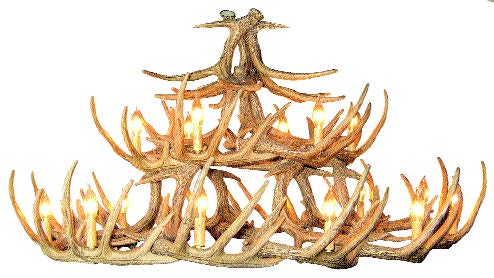THE HUNT, AN APPROXIMATION
Shed antlers make the best chandeliers. Antler searchers, called Hunters, who are mostly females in floppy white hats and khaki shorts, hunt antlers in areas such as Colorado, Missouri, and Texas. This is a sport similar to “mushrooming.” It is common to see Hunters with their “rack sacks” crossing open fields or walking along county highways in early to mid-May. Eight- and ten-point racks can “get” up to three hundred and fifty dollars. Twelve is very large, and once, in Ketchum, Idaho, a Hunter named Mrs. Welsh “turned in” a nineteen-point rack. Broken antlers can also be used for chandeliers, though they are less desirable. Often, broken antlers are left where they are found near “rubbed” trees and fence posts. From a distance they can appear to be large racks and can cause a quickening pulse called Hunt Anxiety (HA) in excitable Hunters. Only the inexperienced and frustrated veterans will “pack-out” broken antlers. During hunting season the ratio of Hunters to antlers available may be as high as 30:1; therefore, antler chandeliers have been known to “go for” as much as two thousand dollars in western resort destinations such as Santa Fe, New Mexico, Steamboat Springs, Colorado, and, of course, Jackson Hole, Wyoming.
ANTLERS, IN DEPTH
Antlers are bony outgrowths that develop and grow from the pedicle, a “bony base,” on top of a male cervid’s skull. Antlers are used in combat during mating season. The size and complexity of the “branch” depends on the cervid’s age and species. Each spring after “the mate” cervids shed their antlers. (It should be stated that horns and antlers are not the same. Horns, commonly found on sheep, goats, and buffalo, are never shed and are actually hair molds similar to dreadlocks. Antlers are calcified tissue, or bone.) While the antlers re-grow they are covered in a dermal covering (or “furry skin”) called “velvet.” This “velvet” is living and supplied with nutrients by a network of blood vessels and a healthy diet of leaves, grass, bugs, stream water, and if available, corn. In August an increase in testosterone production cuts off the blood supply to the antlers causing the “velvet’s” death and stopping the antler’s growth. The “velvet” begins to “bubble and peel” and is rubbed off or “thrashed off” on tree trunks, sapling trees, fallen trees, fallen branches, shrubs, the earth, and sometimes, if present, fence posts. This “rubbing and thrashing” is called the rut, and the cervid makes a strange noise during rut activities. This noise could be called a “yelp.” Sometimes, if rutting occurs with much “yelping” and frustration, the cervid’s antlers may break off prematurely.
THE LIGHT, AN OVERVIEW
Antler chandeliers add rusticity to any...
You have reached your article limit
Sign up for a digital subscription and continue reading all new issues, plus our entire archives, for just $1.50/month.
Already a subscriber? Sign in





